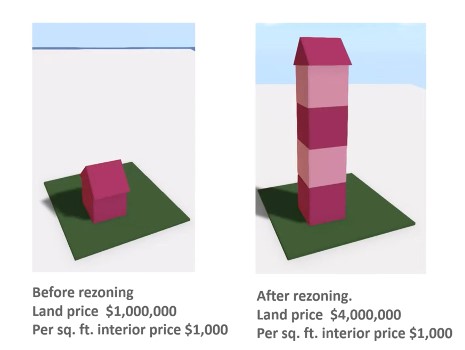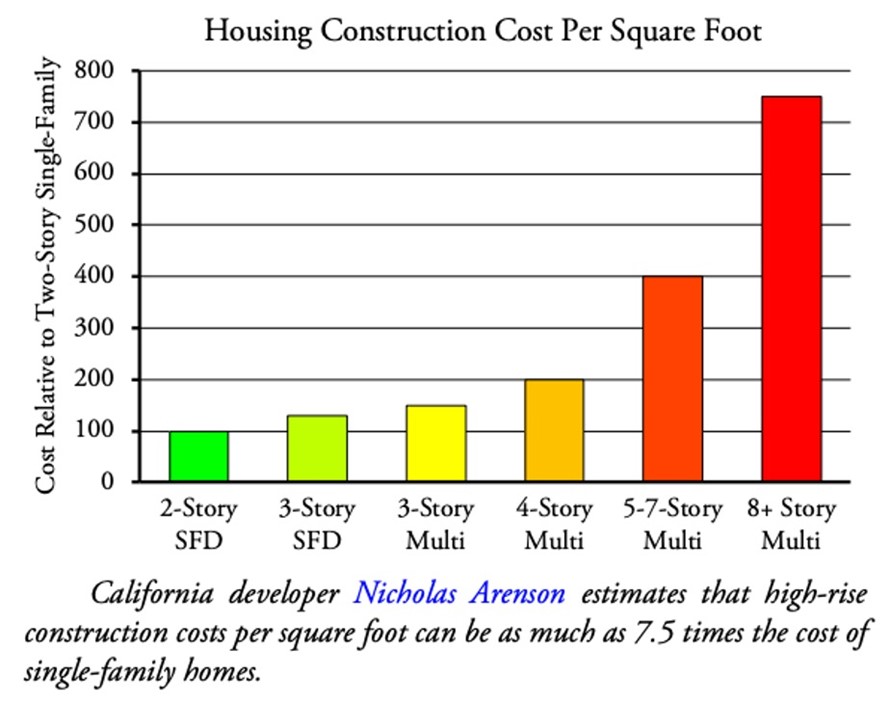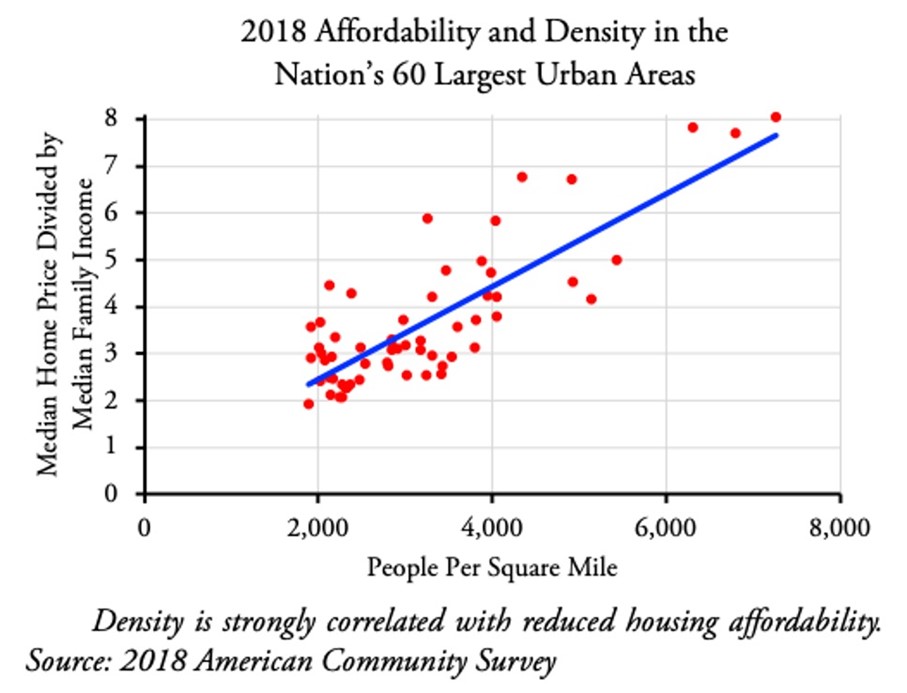Posted by: Sharon Rushton – May 19, 2023 – 7:27pm
Since 2008 and accelerating in 2016, State lawmakers have been following the same playbook, which has been largely written by the lobbying efforts of Big Real Estate, Big Tech, and Big Wall Street Investment Firms in order to augment their investments in residential properties.
To maximize profits from their residential property portfolios, the Power Players have sought to change land use policy and regulations. They have been successful. Recently enacted housing laws take away local control of residential land use and give it to real estate developers to maximize their return on investment (ROI); raise the value of residential properties via up-zoning (increasing density); reduce the cost of residential construction via deregulation (weakening the California Environmental Quality Act – CEQA and development standards) and lower developer fees; and augment rental income by promoting market-rate housing over affordable housing.
Deregulation has included removing democratic public engagement and due process, such as public hearings and environmental analysis. No longer does the local city council, with residents’ input, make decisions. Instead, real estate investors and developers determine where and how much housing growth will occur, with no regard for local conditions, capacity, or adverse impacts.
The subsequent housing densification, population growth, and revision of development standards increases the risk of adverse impacts on the environment, public health and safety, traffic congestion, infrastructure, utilities (water supply), public services, views, sunlight, privacy, neighborhood character, and quality of life.
Yet, real estate investors and housing developers are allowed to make billions without paying anything to offset the adverse impacts caused by all the new housing over-stressing local infrastructure. With no funding for dealing with the above listed impacts, tax paying residents bear the costs of the increased demand and mitigation of environmental impacts, if mitigation is even possible.
False Housing Crisis Narrative
This agenda has been aided and abetted by a finely tuned “False Housing Crisis Narrative”, which includes both a false problem and a false solution.
False Problem
The powerful pro-development forces incorrectly define the housing affordability dilemma by over-inflating the projected population and job growth and, therefore, the number of new housing units needed for that growth. Moreover, the Power Players erroneously claim that every single community in California has the same housing problem (the “One-Size-Fits-All” syndrome). More recently, their ruse calls single-family zoning racist.
The Truth
California’s population growth rate is at a record low and predicted to remain low. The State’s population has shrunk for the last three years, according to the Department of Finance. California’s population declined by 182,083 people in 2020, by 117,552 people in 2021, and by 138,400 people in 2022, putting its population at 38.94 million. This is below where it was in 2016. Despite a declining population growth, the State Legislature continues to call for construction of a whopping 3.5 million homes by 2025.
Regarding the claim that single-family zoning is racist: It is true that prior to the Civil Rights Act of 1964, CC&Rs (Covenants, conditions, and restrictions), Homeowner Associations, and redlining excluded people based on race, color, creed, nationality, and a host of other criteria from certain single-family, duplex, and multi-family neighborhoods. Prior to 1964, segregation and similar prohibitions certainly existed and applied to all types of housing as well as all types of jobs, places, and opportunities. – not just single-family housing. However, this is no longer the case. Today, such exclusion is illegal.
Moreover, the attack on single-family zoning ignores the fact that homeownership is a crucial tool for communities of color to build wealth.
A 2013 study by researchers at Harvard University’s Joint Center for Housing Studies lays out several valuable points about homeownership for people of color. First, in real-life practice, homeowners are more likely to accumulate wealth than renters. Also, homeownership has meaningful social benefits in which people feel a sense of success, have control over their living situation, and can put down roots in a community. The Harvard researchers noted, policymakers should help people succeed as homeowners.
False Solution
The Big Powers wrongly tout that the solution to meet the exaggerated housing requisite, is a troubling “Trickle-Down” housing agenda. This agenda plays out this way: Deregulate land use as much as possible, a market-rate apartment construction boom will follow, and eventually sky-high rents will stabilize and drop since more units have come onto the market. It’s the outdated, supply-and-demand argument.
A huge part of this erroneous solution is to increase housing density. They wrongly assert that higher density housing is more affordable.
The Truth
However, the truth is that the deceptive “Trickle-Down” housing strategy results in very high demand at the low end of the market being met with more supply at the high end and creates an imbalance that only contributes to growing affordability concerns. Moderate and lower-income residents are left behind. They can’t afford market-rate units. The strategy also fuels gentrification in working-class communities, where new, over-priced apartments often replace existing affordable housing.
Higher Density Makes Housing Less Affordable
Regarding housing density, the reality is that higher density makes housing less affordable.
Once density limitations are removed, the parcels of land affected will immediately increase in value because there is more profit to be made per parcel. Higher land prices make housing more expensive. Developers pay a premium just to get a project off the ground.
In 2021, Patrick Condon, Professor at the University of British Columbia School of Architecture, Landscape Architect, Author, and Former City Planner, gave a presentation to Livable California about his latest book entitled; “Sick City”.
For years, Condon had been a supporter of widespread up-zoning in Vancouver, a theory embraced to reduce housing costs, but up-zoning backfired.
Condon reported:
“We have incrementally quadrupled the density of Vancouver, but we haven’t seen any decrease in per square foot costs. The evidence is indisputable. We can conclude that there is a problem beyond restrictive zoning. No amount of opening zoning or allowing for development will cause prices to go down. We’ve seen no evidence of that all. It’s the global increase in land value in urban areas that is the problem.”

Slide from Patrick Condon’s presentation about his book entitled; “Sick City”
High-density-advocates claim that developers can overcome high land costs by building higher densities. However, the cost of high-density construction is significantly greater, per square foot, than low-density construction.
California Developer Nicholas Arenson gave a presentation entitled; “The Deal Approach“ to two regional planning bodies (the Metropolitan Transportation Commission (MTC) and the Association of Bay Area Governments (ABAG)). He testified that buildings that are three stories tall or taller require more steel, concrete, and elevators, making construction cost per square foot much higher than one- or two-story single-family homes.
More specifically, Arenson calculated that building three stories costs 30 to 50 percent more, per square foot, than two stories; four to seven stories costs 100 to 300 percent more; and eight or more stories costs 450 to 650 percent more.

Slide from Real Estate Developer Nicholas Arenson’s presentation entitled; “Deal Approach”
Land-use and Transportation Policy Analyst Randal O’Toole’s comparison of the density of American urban areas with their housing affordability shows a clear correlation: Density makes housing less affordable, not more.
In his policy brief entitled; “Make Housing Affordable by Ending the New Feudalism”, Randal O’Toole states:
“Density Is Not the Solution. There is no evidence that single-family zoning makes housing more expensive or that abolishing it will make it more affordable. By 1960, almost every city in America except Houston had approved zoning codes that put large portions of their cities in single-family zoning. Yet housing remained very affordable nationwide.”
“Contrary to those who say that density is the solution to affordability problems, California urban areas have become less affordable even as their densities increased. Between 1970 and 2018, the population density of the Los Angeles urban area grew by 37 percent while its price-to-income ratio grew from 2.2 to 8.0. The density of the San Francisco-Oakland urban area grew by 55 percent while its price-to-income ratio grew from 2.3 to 7.7. The density of the San Jose urban area grew by 71 percent while its price-to-income ratio grew from 2.2 to 7.8.”

Chart from Policy Analyst Randal O’Toole’s policy brief entitled; “Make Housing More Affordable by Ending the New Feudalism”
“Comparing densities and affordability in the nation’s 60 largest urban areas reveals a strong negative correlation between the two. Of these urban areas, none whose price-per-income ratio is under three has a density greater than 3,600 people per square mile. No urban area whose density is greater than 4,100 people square mile has a price-per-income ratio less than 4, and most are more than 6. The correlation coefficient between density and price-to-income ratios is 0.82, which is particularly strong.”
Abolishing single-family zoning and up-zoning in general won’t make housing more affordable because it doesn’t solve the problems of high land prices and higher construction costs of multi-story buildings.
For years, the Power Players’ and State lawmakers’ propaganda has claimed that their agenda will result in more affordable housing. Yet, more than half of Californians are still concerned about their ability to pay housing costs, according to the results of a 2022 Survey conducted by the Public Policy Institute of California. Middle and working-class Californians continue to be rent burdened, drowning in sky-high rents charged by corporate landlords, major real estate companies, and predatory landlords. The number of California’s homeless has risen to over 170,000. It’s obvious that the Power Players’ Playbook only benefits the Power Players.
Better Solutions
The State will never solve the housing affordability crisis by following the same scheme that has failed over and over again. What is really needed is a sustainable State investment that matches the scale of the problem. This means ongoing State funding to subsidize local affordable housing solutions that follow local land-use and development regulations and to subsidize mitigations for adverse environmental impacts that will result from increased population and development. Moreover, the State should empower small, local, low-income housing developers and low-income home buyers with financial incentives, such as tax credits and creative lending strategies.
For more specific ways to stimulate the production of affordable housing without destroying local communities, please read Bob Silvestri’s article entitled; “10 Things We Can Do Now To Promote Affordable Housing.”
For additional solutions to our housing affordability dilemma, please read the very last Section – “A Better Way” of my article entitled; “The Housing Crisis Propaganda Machine”. You will need to scroll all the way down to the end of the article to read this section.
TAKE ACTION!
- Support the Our Neighborhood Voices Initiative
To dismantle the Power Players’ Problematic Playbook, please support the Our Neighborhood Voices Initiative. The Initiative, if successful, will amend the State Constitution to ensure zoning, land-use and development decisions are made at the local level and to stop the multitude of legislative bills that seek to override municipal and county control over land-use and development.
Please click HERE to learn more about the Our Neighborhood Voices Initiative.
- Lobby Your Supervisors, City Mayors, and City Councilmembers to join the Senate Bill 9 Lawsuit.
The lawsuit could roll back Senate Bill 9.
Please click HERE to learn more about SB-9.
Please click HERE to learn more about the SB-9 lawsuit.
- Lobby Your Supervisors, City Mayors, and City Councilmembers to join the lawsuit against HCD.
The law firm of Aleshire and Wynder is seeking petitioners (cities, counties, and government agencies) to jointly file a legal action against the California Department of Housing and Community Development (HCD) for violations of state statutes and other actions that are placing illegitimate housing quota burdens on California cities and counties, quotas that are unsupported by facts and available data on future housing needs.
Please click HERE to learn more about the Regional Housing Needs Allocation State Audit and Potential Lawsuit against HCD by California Cities and Counties.

